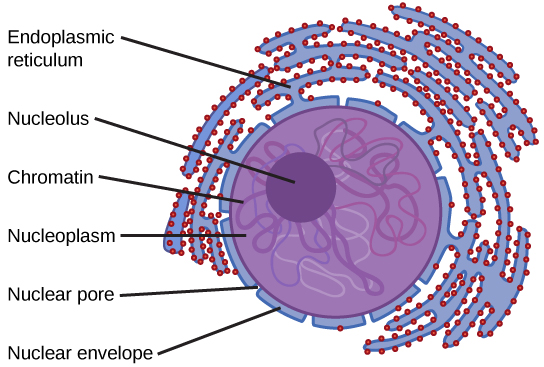
Draw a well labelled diagram of an eukaryotic nucleus. How is it different from nucleoid?
Answer
481.2k+ views
1 likes
Hint:- In eukaryotes, the cells are not primitive, having distinct membranes around the organelles. The eukaryotic nucleus is prominent. It is enclosed in a nuclear membrane. The nucleus of the eukaryotic cells contains nucleoli.
Complete answer:-
In eukaryotic cells, the nucleus is a double membrane-bound. It is well developed. It contains the genome of the organism which is DNA. It is the main integrity of a cell. It controls all the main processes of the cell. It is the largest organelle of a cell and also supports transcription and replication processes. The nucleus contains and protects the genetic material. This genetic material is in the form of DNA along with histone and non-histone proteins making up the chromatin network.
The nucleus is attached to a network of the endoplasmic reticulum. The endoplasmic reticulum has several ribosomes around it thus making it a rough endoplasmic reticulum. Nucleoid is basically an area that is irregular in shape. It is present in a prokaryotic (primitive) cell. Nucleoid is the genetic material of a prokaryotic cell. It is not surrounded by an envelope. It lies just scattered in the cytoplasm. The area contains the chromosome. The functions of the nucleoid are the same as the nucleus of a eukaryotic cell.

Note: Organisms of all the other kingdoms except monera are eukaryotic. Protista, Animalia, Plantae, and Fungi are all eukaryotic. The chromatin material present in the nucleus condenses in the form of chromosomes at the time of cell division. The protoplasm present inside the nucleus is known as the nucleoplasm.
Complete answer:-
In eukaryotic cells, the nucleus is a double membrane-bound. It is well developed. It contains the genome of the organism which is DNA. It is the main integrity of a cell. It controls all the main processes of the cell. It is the largest organelle of a cell and also supports transcription and replication processes. The nucleus contains and protects the genetic material. This genetic material is in the form of DNA along with histone and non-histone proteins making up the chromatin network.
The nucleus is attached to a network of the endoplasmic reticulum. The endoplasmic reticulum has several ribosomes around it thus making it a rough endoplasmic reticulum. Nucleoid is basically an area that is irregular in shape. It is present in a prokaryotic (primitive) cell. Nucleoid is the genetic material of a prokaryotic cell. It is not surrounded by an envelope. It lies just scattered in the cytoplasm. The area contains the chromosome. The functions of the nucleoid are the same as the nucleus of a eukaryotic cell.

Note: Organisms of all the other kingdoms except monera are eukaryotic. Protista, Animalia, Plantae, and Fungi are all eukaryotic. The chromatin material present in the nucleus condenses in the form of chromosomes at the time of cell division. The protoplasm present inside the nucleus is known as the nucleoplasm.
Recently Updated Pages
Master Class 12 Business Studies: Engaging Questions & Answers for Success

Master Class 12 English: Engaging Questions & Answers for Success

Master Class 12 Social Science: Engaging Questions & Answers for Success

Master Class 12 Chemistry: Engaging Questions & Answers for Success

Class 12 Question and Answer - Your Ultimate Solutions Guide

Master Class 11 Economics: Engaging Questions & Answers for Success

Trending doubts
Draw a labelled sketch of the human eye class 12 physics CBSE

a Tabulate the differences in the characteristics of class 12 chemistry CBSE

Which one of the following is a true fish A Jellyfish class 12 biology CBSE

Why is the cell called the structural and functional class 12 biology CBSE

Differentiate between homogeneous and heterogeneous class 12 chemistry CBSE

Write the difference between solid liquid and gas class 12 chemistry CBSE




